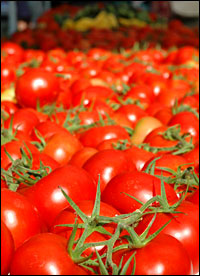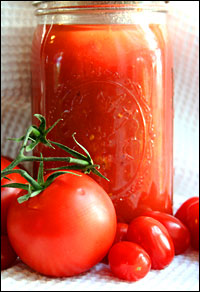
Too much of a good thing?
Photos: Kurt Michael Friese
For a tomato-loving gardener, what’s the only thing more frightening than a failed crop? Try an overabundant one. You become terrified that any of these jewels will go to waste. The specter of fruit flies congregating on the compost heap brings regret of over-ambitious spring garden planning. Even in my restaurant garden, which has the advantage of a commercial outlet, the burden of preserving it all can be heavy.
Well, take heart, gentle reaper: There is plenty that can be done with all that red, green, and gold bounty. This year is shaping up to be a bumper-buster at Devotay Gardens, so I thought I’d share what we’re going to be doing and how you can do it at home.
Yes, You Can
After we’ve sold all we can fresh, it’s time for the “puttin’ up.” There are three main ways to preserve tomatoes, each requiring varying levels of time, expertise, and equipment.

Can you dig it?
We have plenty of help at the restaurant, but for the home cook, the most enjoyable way to go about any or all of these methods is to create your own kitchen crew by inviting a few of your fellow gardeners over for a Saturday afternoon of canning, freezing, and drying. If everybody brings their own excess and then works together on all the preparation, the time goes much faster and more pleasurably. In addition, you will have included the most important ingredient: love.
Well, there is one other thing that might be a little more important to the finished product: sanitation. Everything must be scrupulously clean and sterile. Also, accomplishing the correct acid balance will help protect the tomatoes’ flavor as well as preserving them. Use 2 tablespoons of lemon juice or 1/2 teaspoon of citric acid per quart of canned tomatoes. Always follow the instructions that come with your canning equipment, or turn to the old standby, The Joy of Cooking, for information on how to can safely. Do it right: Nothing ruins a February summer-in-a-can pasta dinner like botulism.
Cut and Dried
Another great way to preserve tomatoes is to dry them. Sun-dried tomatoes are a staple in my kitchens, both at home and at the restaurant. While they do take a lot of time, they require very little active participation. All you need is a few pieces of equipment and a safe, sunny spot away from critters like dogs or coons.
Most people choose Roma tomatoes for drying, but any tomato will do. Core the tomatoes using a tomato shark, a handy gadget that is like a scoop with teeth, available at any kitchen store. Split the tomatoes in half lengthwise, gently squeeze out the seeds and water, and lay the tomatoes on a framed screen. An old window screen will do, as long as it is clean. Lightly salt the tomatoes, and then add some chopped fresh herb like rosemary, oregano or basil, and sugar if desired. Cover with cheesecloth or another screen, being careful that the top one does not come into contact with the tomatoes. Set them out in a sunny but protected spot; often a deck or a rooftop works well. They may take anywhere from 4 days to 2 weeks, but they are worth it. Remember to bring them inside each night so that the dew does not spoil them.

Vine and dandy.
OK, looking for the shortcut? Tomatoes can be dried in your oven overnight on the lowest setting or just with the pilot light burning. Core and cut them as before and lay them on a parchment-covered sheet pan. Add salt and herbs and place in the oven on very low overnight. These dried tomatoes do not have quite the same character as their more traditional sun-dried siblings, but they are quite good nonetheless.
Another great way to use a multitude of tomatoes is to make and freeze a big batch of traditional tomato sauce. To begin, you must peel all your tomatoes. This is done by coring them with the aforementioned “shark,” then plunging them, a few at a time, into boiling salted water for 30 to 45 seconds. Remove them immediately and “shock” them by immediately plunging them into ice water until they are cold enough to handle. Repeat this with all the tomatoes. The skin will loosen and be easy to remove with your hands or a paring knife. Crush these skinned tomatoes into a bowl by squeezing them with your hands. This whole process can be messy, but it is fun if you get a group of friends working together.
Traditional Tomato Sauce (for freezing)
2 red onions, minced
8 garlic cloves, minced
1/4 cup fresh chopped thyme
1 carrot, grated
Olive oil to cover bottom of a large saucepot
Sauté onions, garlic, thyme, and carrot in olive oil over medium heat in a large saucepot until tender, being careful not to let the mixture brown. Add the tomatoes and stir, bring to a simmer, and stir frequently over medium-low heat for at least an hour, or until the consistency is like a loose oatmeal. Cool completely, then freeze in well-labeled Ziploc bags. Note the lack of salt: You don’t want to salt it until you are ready to use it. The salt may taste great at that moment, but once you thaw, heat, and reduce this sauce to use in your favorite recipe, it would become too salty.
If after all this, you still have tomatoes left, bring them to me. I can never get enough.


